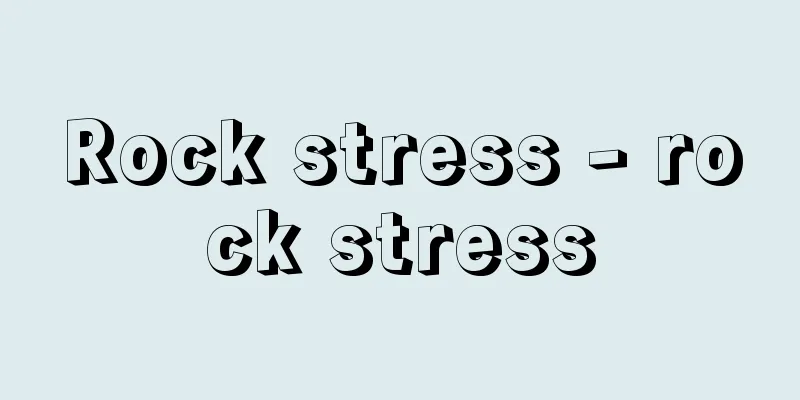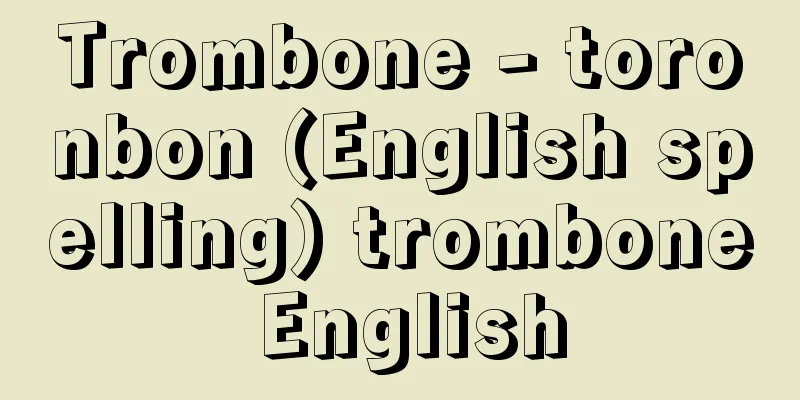Rail - rail (English spelling)

|
A steel strip with a special cross-sectional shape that directly supports the load of railway vehicles, distributing it among the sleepers, while providing a smooth running surface to guide the vehicles. [Fujio Fukuyama] kindsThey are classified according to their cross-sectional shape and mass. Different cross-sectional shapes are used in different countries around the world. In Japan, they are standardized by the Japanese Industrial Standards (JIS)-E1011 (normal rails) and the JR standard (JRS), and are distinguished by the calculated mass per meter. [Fujio Fukuyama] Classification by massThere are currently six types of JIS standards: 30 kg, 37 kg, 50 kg, 60 kg, 40 kgN, and 50 kgN. The standard length is 25 meters, and they are connected with joint plates. However, in many aspects, such as the ride comfort of the vehicle, noise, track maintenance, and rail damage, the joints are the weakest point of the track. JR uses rails of over 200 meters made of 25 meter rails welded together on its main lines, and calls them long rails. [Fujio Fukuyama] Cross-sectional shapeIt consists of a head, a middle section, and a bottom section. The head section, which is always in contact with the wheels, has a cross-sectional shape that minimizes wear due to contact and allows for some margin for loss of cross-section due to wear, ensuring smooth running of the vehicle. The middle section transmits the load of the vehicle from the head to the bottom section, and is designed to have sufficient rigidity while minimizing the amount of material used. The shape of the bottom section is determined by taking into consideration the balance of the overall cross-section, the rolling conditions during manufacturing, and the loss of cross-section due to corrosion over long-term use, while ensuring stable attachment to the sleepers. [Fujio Fukuyama] qualitySteel is an alloy of iron and carbon, with the amount of each varying depending on the application. Rail steel is a high-carbon steel with a high carbon content, composed of iron, carbon, silicon, manganese, sulfur, and phosphorus. Carbon combines with iron to form hard iron carbide crystals called cementite, which are distributed in layers within the soft iron-only ferrite crystals. The more carbon there is, the harder the steel will be, and the less carbon there is, the softer the steel will be. Silicon acts as a deoxidizer, removing oxygen that remains in the form of bubbles when molten steel solidifies. Manganese, along with acting as a deoxidizer, also serves as a desulfurizer, removing sulfur, which reduces toughness. Sulfur and phosphorus are contained in the raw materials for steelmaking, but they are harmful elements that deteriorate steel, so it is necessary to reduce their content as much as possible. The strength of a rail, i.e. its mechanical properties, is expressed in terms of tensile strength and elongation. It is said that the higher the tensile strength, the more durable the rail will be, but the lower the elongation will be. [Fujio Fukuyama] Rail Use in JapanWhen the Shinbashi-Yokohama section first opened in 1872 (Meiji 5), double-headed rails with the same cross section at the top and bottom were used. Later, 30 kg and 37 kg rails were adopted in 1906 (Meiji 39), and 50 kg rails in 1928 (Showa 3). After World War II, 40 kg N and 50 kg N rails began to be used by JNR in 1961 (Showa 36). 50 kg T rails were used on the Tokaido Shinkansen, which opened in 1964, and 60 kg rails were used on the Sanyo Shinkansen in 1967. In former JNR sections, it was decided from 1965 that 60 kg rails would be used on higher-class lines and 50 kg N rails on lower-class lines. In sharp curve sections, the outer rail wears faster than in straight sections, so heat-treated rails with hardened and tempered heads are used. Also, in 25-meter standard-length rail sections, heat-treated end head rails are used, with the heads of the rails heat-treated to withstand impacts at the joints. [Fujio Fukuyama] "Rails" by Kato Yasuo (1978, Japan Railway Facilities Association) ©Shogakukan "> Rail Part Names ©Shogakukan "> Main types of rails Source: Shogakukan Encyclopedia Nipponica About Encyclopedia Nipponica Information | Legend |
|
鉄道車両の荷重を直接支持して枕木(まくらぎ)に分散させるとともに、平滑な走行面を与え車両を誘導する特殊断面形状をした帯状の鋼製品。 [福山富士夫] 種類断面形状と質量によって区分される。世界各国で、それぞれ違った断面形状が使用されている。日本では日本工業規格(JIS(ジス))‐E1011(普通レール)と、JRの規格(JRS)で規格化され、1メートル当り計算質量で区別している。 [福山富士夫] 質量による区分現在のJIS規格の種類は、30キログラム、37キログラム、50キログラム、60キログラム、40キログラムN、50キログラムNの6種類である。標準長は25メートルで、継目板によって接続して使用する。しかし、車両の乗り心地、騒音、軌道保守、レール損傷など多くの面から、継ぎ目部は線路の最大の弱点となっている。JRでは25メートルレールを溶接した200メートル以上のレールを主要線区に使用してロングレールとよんでいる。 [福山富士夫] 断面形状頭部、腹部、底部から構成されている。つねに車輪が接触する頭部は、接触による摩耗を最小に抑え、また摩耗による断面の減少に対しての余裕のある断面形状とし、車両の円滑な走行を図っている。腹部は車両の荷重を頭部から底部に伝達する部分で、十分な剛性をもちながら材料の使用量を最低にする考慮がなされる。底部の形状は、枕木上に安定して定着し、車両重量による横転への抵抗力があり、しかも、全体の断面の均衡、製造上の圧延条件、長期に使用した場合の腐食による断面減少などを考慮して決定する。 [福山富士夫] 品質鋼は鉄と炭素の合金で、用途によって配分量が異なる。レール鋼は炭素が多い高炭素鋼で、鉄、炭素、ケイ素、マンガン、硫黄(いおう)、リンによって構成されている。炭素は鉄と化合してセメンタイトとよばれる炭化鉄の硬い結晶になり、鉄だけの軟らかいフェライトの結晶の中に層状に分布する。炭素が多いほど硬く、少ないほど軟らかい鋼となるわけである。ケイ素は、溶鋼が固まる際に気泡となって残留する酸素を除去する脱酸剤として作用する。マンガンは、脱酸剤とともに、靭性(じんせい)(ねばり強さ)を低下させる硫黄を除去する脱硫剤としての役目をする。硫黄とリンは製鉄原料中に含有されているが、鋼を劣化させる有害元素なので、できるだけ少なくすることが必要である。 レールの強さ、すなわち機械的性質は、引張り強さと伸びとで表される。引張り強さが大きいほど耐久力があるとされているが、伸びは小さくなる。 [福山富士夫] 日本でのレールの使用1872年(明治5)新橋―横浜間の開業当初は、頭部と底部が同じ断面の双頭レールが使用されていた。その後、1906年(明治39)には30キログラムと37キログラムレールが、28年(昭和3)には50キログラムレールが採用された。第二次世界大戦後、61年(昭和36)に、40キログラムNと50キログラムNレールが国鉄で使用され始めた。64年開業の東海道新幹線には50キログラムTレールが、67年の山陽新幹線には60キログラムレールが使われた。旧国鉄区間では、1965年から上級線区には60キログラムレール、下級線区には50キログラムNレールを使用することが決められた。 急曲線区間での外軌側レールは、直線区間に比べて摩耗速度が速いので、レール頭部に焼入れ・焼戻しの熱処理をした頭部熱処理レールが使用されている。また25メートルの標準長レール区間では、継ぎ目部分の衝撃に耐えるために、レールの端の頭部に熱処理を施した端頭部熱処理レールが使われている。 [福山富士夫] 『加藤八州夫著『レール』(1978・日本鉄道施設協会)』 ©Shogakukan"> レールの各部名称 ©Shogakukan"> レールのおもな種類 出典 小学館 日本大百科全書(ニッポニカ)日本大百科全書(ニッポニカ)について 情報 | 凡例 |
>>: Nikolai Konstantinovich Rerikh
Recommend
North Osaka region
...Therefore, various plans for the regeneration ...
Oneirophrenia
...In Japan, the following three different states...
History of economic theory
[The Significance of Researching the History of E...
Fliess, W. (English spelling) FliessW
...The fact that Freud placed the greatest import...
Labor Exchange (English: bourse du travail)
A type of labor union found in France and Italy. I...
Sun Bug (Sun Bug) - Sun Bug
A general term for protozoa belonging to the super...
Chromolithography
...What broke this stagnation of lithography was ...
Kaneuji
?-? A swordsmith from the Kamakura to Nanboku-cho...
Thelepus setosus (English spelling) Thelepussetosus
...Many of them live inside the thin membranous t...
brown shrike
...In Japan, it breeds in various places from Kyu...
Nucleus (nerve) -
... The length of the spinal cord in an adult is ...
Herman Wouk
American Jewish author. Born in New York, he grad...
Milano (English spelling)
Milan is the capital of Lombardy, a region in nor...
Negi - Green onion
〘Noun〙 (The noun derived from the conjunctive form...
Performer
〘 noun 〙 (also "enja") 1. A person who e...
![Koshino [village] - Koshino](/upload/images/67cb93e54ea9d.webp)








